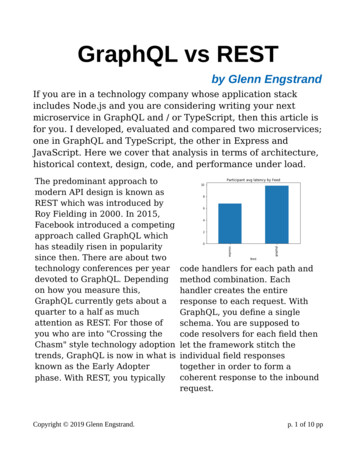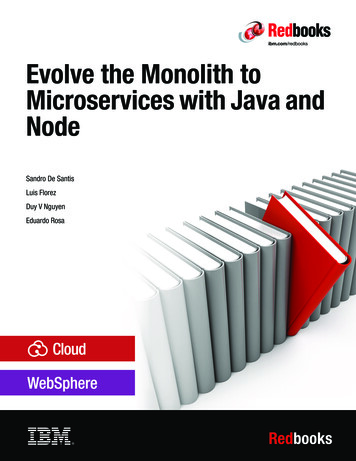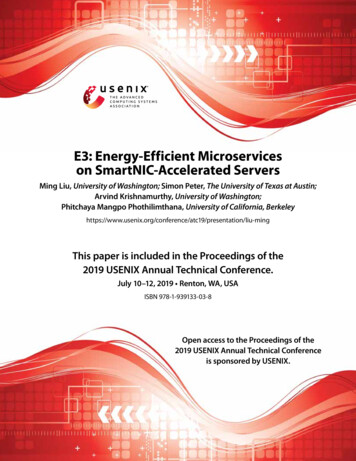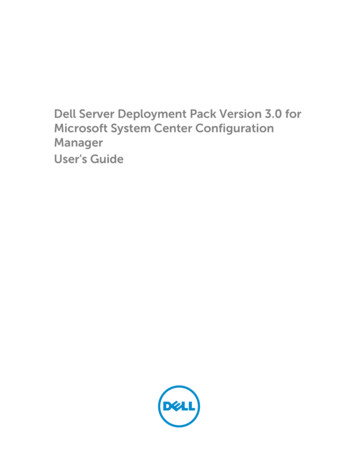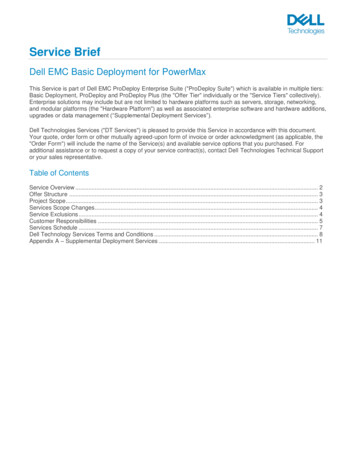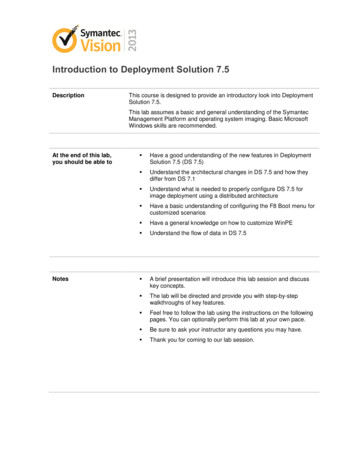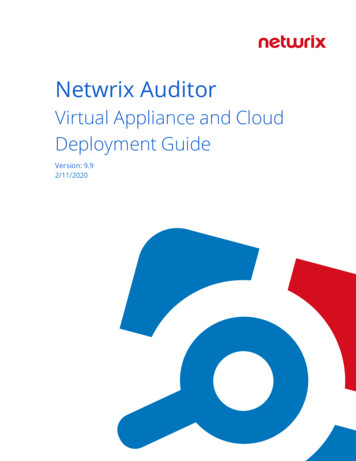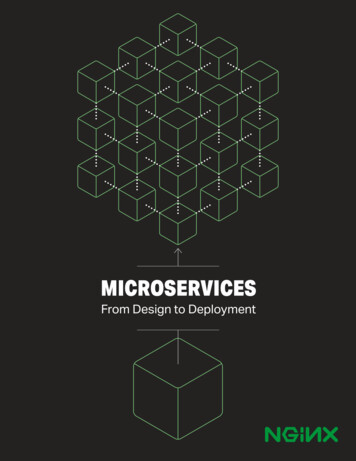
Transcription
From Design to Deployment01
From Design to Deploymentby Chris Richardsonwith Floyd Smith NGINX, Inc. 201602
Table of ContentsForeword . . . . . . . . . . . . . . . . . . . . . . . . . . . . . . . . . . . . . iii1 Introduction to Microservices . . . . . . . . . . . . . . . . . . . . . .1Building Monolithic Applications . . . . . . . . . . . . . . . . . . . . . 1Marching Toward Monolithic Hell . . . . . . . . . . . . . . . . . . . . . 3Microservices – Tackling the Complexity . . . . . . . . . . . . . . . . 4The Benefits of Microservices . . . . . . . . . . . . . . . . . . . . . . . 8The Drawbacks of Microservices . . . . . . . . . . . . . . . . . . . . . 9Summary . . . . . . . . . . . . . . . . . . . . . . . . . . . . . . . . . . . . 11Microservices in Action: NGINX Plus as a Reverse Proxy Server . . 112 Using an API Gateway . . . . . . . . . . . . . . . . . . . . . . . . . . . 12Introduction . . . . . . . . . . . . . . . . . . . . . . . . . . . . . . . . . . 12Direct Client-to-Microservice Communication . . . . . . . . . . . 15Using an API Gateway . . . . . . . . . . . . . . . . . . . . . . . . . . . . 15Benefits and Drawbacks of an API Gateway . . . . . . . . . . . . . 17Implementing an API Gateway . . . . . . . . . . . . . . . . . . . . . . 17Performance and Scalability . . . . . . . . . . . . . . . . . . . . . 17Using a Reactive Programming Model . . . . . . . . . . . . . . 18Service Invocation . . . . . . . . . . . . . . . . . . . . . . . . . . . . 18Service Discovery . . . . . . . . . . . . . . . . . . . . . . . . . . . . 19Handling Partial Failures . . . . . . . . . . . . . . . . . . . . . . . . 19Summary . . . . . . . . . . . . . . . . . . . . . . . . . . . . . . . . . . . . 20Microservices in Action: NGINX Plus as an API Gateway . . . . 203 Inter-Process Communication . . . . . . . . . . . . . . . . . . . . . 21Introduction . . . . . . . . . . . . . . . . . . . . . . . . . . . . . . . . . . 21Interaction Styles . . . . . . . . . . . . . . . . . . . . . . . . . . . . . . 22Defining APIs . . . . . . . . . . . . . . . . . . . . . . . . . . . . . . . . . . 24Evolving APIs . . . . . . . . . . . . . . . . . . . . . . . . . . . . . . . . . . 24Handling Partial Failure . . . . . . . . . . . . . . . . . . . . . . . . . . . 25IPC Technologies . . . . . . . . . . . . . . . . . . . . . . . . . . . . . . 26Asynchronous, Message-Based Communication . . . . . . . . . 26Synchronous, Request/Response IPC . . . . . . . . . . . . . . . . 29REST . . . . . . . . . . . . . . . . . . . . . . . . . . . . . . . . . . . . 29Thrift . . . . . . . . . . . . . . . . . . . . . . . . . . . . . . . . . . . . . 31Message Formats . . . . . . . . . . . . . . . . . . . . . . . . . . . . . . 31Summary . . . . . . . . . . . . . . . . . . . . . . . . . . . . . . . . . . . . 32Microservices in Action: NGINX and Application Architecture . . 33i
456Service Discovery . . . . . . . . . . . . . . . . . . . . . . . . . . . . . 34Why Use Service Discovery? . . . . . . . . . . . . . . . . . . . . . . . 34The Client-Side Discovery Pattern . . . . . . . . . . . . . . . . . . . 35The Server-Side Discovery Pattern . . . . . . . . . . . . . . . . . . 37The Service Registry . . . . . . . . . . . . . . . . . . . . . . . . . . . . 38Service Registration Options . . . . . . . . . . . . . . . . . . . . . . . 39The Self-Registration Pattern . . . . . . . . . . . . . . . . . . . . . . 39The Third-Party Registration Pattern . . . . . . . . . . . . . . . . . . 41Summary . . . . . . . . . . . . . . . . . . . . . . . . . . . . . . . . . . . . 42Microservices in Action: NGINX Flexibility . . . . . . . . . . . . . . 43Event-Driven Data Management for Microservices . . . . . . .Microservices and the Problem of DistributedData Management . . . . . . . . . . . . . . . . . . . . . . . . . . . . . .Event-Driven Architecture . . . . . . . . . . . . . . . . . . . . . . . . .Achieving Atomicity . . . . . . . . . . . . . . . . . . . . . . . . . . . . .Publishing Events Using Local Transactions . . . . . . . . . . . .Mining a Database Transaction Log . . . . . . . . . . . . . . . . . .Using Event Sourcing . . . . . . . . . . . . . . . . . . . . . . . . . . . .Summary . . . . . . . . . . . . . . . . . . . . . . . . . . . . . . . . . . . .Microservices in Action: NGINX and Storage Optimization . . .44Choosing a Microservices Deployment Strategy . . . . . . . .Motivations . . . . . . . . . . . . . . . . . . . . . . . . . . . . . . . . . .Multiple Service Instances per Host Pattern . . . . . . . . . . . .Service Instance per Host Pattern . . . . . . . . . . . . . . . . . . .Service Instance per Virtual Machine Pattern . . . . . . . . . . . .Service Instance per Container Pattern . . . . . . . . . . . . . . .Serverless Deployment . . . . . . . . . . . . . . . . . . . . . . . . . .Summary . . . . . . . . . . . . . . . . . . . . . . . . . . . . . . . . . . . .Microservices in Action: Deploying MicroservicesAcross Varying Hosts with NGINX . . . . . . . . . . . . . . . . . . . .55555658586062634447505051525454637 Refactoring a Monolith into Microservices . . . . . . . . . . . . . 64Overview of Refactoring to Microservices . . . . . . . . . . . . . .Strategy #1: Stop Digging . . . . . . . . . . . . . . . . . . . . . . . . .Strategy #2: Split Frontend and Backend . . . . . . . . . . . . . . .Strategy #3: Extract Services . . . . . . . . . . . . . . . . . . . . . .Prioritizing Which Modules to Convert into Services . . . . .How to Extract a Module . . . . . . . . . . . . . . . . . . . . . . .Summary . . . . . . . . . . . . . . . . . . . . . . . . . . . . . . . . . . . .Microservices in Action: Taming a Monolith with NGINX . . . . .6566676969697172Resources for Microservices and NGINX . . . . . . . . . . . . . . 73ii
Forewordby Floyd SmithThe rise of microservices has been a remarkable advancement in applicationdevelopment and deployment. With microservices, an application is developed,or refactored, into separate services that “speak” to one another in a well-defined way –via APIs, for instance. Each microservice is self-contained, each maintains its owndata store (which has significant implications), and each can be updated independentlyof others.Moving to a microservices-based approach makes app development faster and easierto manage, requiring fewer people to implement more new features. Changes can bemade and deployed faster and easier. An application designed as a collection ofmicroservices is easier to run on multiple servers with load balancing, making it easyto handle demand spikes and steady increases in demand over time, while reducingdowntime caused by hardware or software problems.Microservices are a critical part of a number of significant advancements that arechanging the nature of how we work. Agile software development techniques, movingapplications to the cloud, DevOps culture, continuous integration and continuousdeployment (CI/CD), and the use of containers are all being used alongside microservicesto revolutionize application development and delivery.NGINX software is strongly associated with microservices and all of the technologieslisted above. Whether deployed as a reverse proxy, or as a highly efficient web server,NGINX makes microservices-based application development easier and keepsmicroservices-based solutions running smoothly.With the tie between NGINX and microservices being so strong, we’ve run a seven-partseries on microservices on the NGINX website. Written by Chris Richardson, who hashad early involvement with the concept and its implementation, the blog posts coverthe major aspects of microservices for app design and development, including how tomake the move from a monolithic application. The blog posts offer a thorough overviewof major microservices issues and have been extremely popular.iii
In this ebook, we’ve converted each blog post to a book chapter, and added a sidebarto each chapter with information relevant to implementing microservices in NGINX.If you follow the advice herein carefully, you’ll solve many potential developmentproblems before you even start writing code. This book is also a good companionto the NGINX Microservices Reference Architecture, which implements much of thetheory presented here.The book chapters are:1. Introduction to Microservices – A clear and simple introduction to microservices,from its perhaps overhyped conceptual definition to the reality of how microservicesare deployed in creating and maintaining applications.2. Using an API Gateway – An API Gateway is the single point of entry for your entiremicroservices-based application, presenting the API for each microservice. NGINX Pluscan effectively be used as an API Gateway with load balancing, static file caching,and more.3. Inter-process Communication in a Microservices Architecture – Once you breaka monolithic application into separate pieces – microservices – the pieces need tospeak to each other. And it turns out that you have many options for inter-processcommunication, including representational state transfer (REST). This chapter givesthe details.4. Service Discovery in a Microservices Architecture – When services are runningin a dynamic environment, finding them when you need them is not a trivial issue.In this chapter, Chris describes a practical solution to this problem.5. Event-Driven Data Management for Microservices – Instead of sharing a unifiedapplication-wide data store (or two) across a monolithic application, each microservicemaintains its own unique data representation and storage. This gives you greatflexibility, but can also cause complexity, and this chapter helps you sort through it.6. Choosing a Microservices Deployment Strategy – In a DevOps world, how you dothings is just as important as what you set out to do in the first place. Chris describesthe major patterns for microservices deployment so you can make an informedchoice for your own application.7. Refactoring a Monolith into Microservices – In a perfect world, we would always getthe time and money to convert core software into the latest and greatest technologies,tools, and approaches, with no real deadlines. But you may well find yourself convertinga monolith into microservices, one small piece at a time. Chris presents astrategy for doing this sensibly.We think you’ll find every chapter worthwhile, and we hope that you’ll come back to thisebook as you develop your own microservices apps.Floyd SmithNGINX, Inc.iv
1Introduction toMicroservicesMicroservices are currently getting a lot of attention: articles, blogs, discussions onsocial media, and conference presentations. They are rapidly heading towards the peakof inflated expectations on the Gartner Hype cycle. At the same time, there are skepticsin the software community who dismiss microservices as nothing new. Naysayers claimthat the idea is just a rebranding of service-oriented architecture (SOA). However, despiteboth the hype and the skepticism, the Microservices Architecture pattern has significantbenefits – especially when it comes to enabling the agile development and delivery ofcomplex enterprise applications.This chapter is the first in this seven-chapter ebook about designing, building,and deploying microservices. You will learn about the microservices approach andhow it compares to the more traditional Monolithic Architecture pattern. This ebookwill describe the various elements of a microservices architecture. You will learn aboutthe benefits and drawbacks of the Microservices Architecture pattern, whether it makessense for your project, and how to apply it.Let’s first look at why you should consider using microservices.Building Monolithic ApplicationsLet’s imagine that you were starting to build a brand new taxi-hailing applicationintended to compete with Uber and Hailo. After some preliminary meetings andrequirements gathering, you would create a new project either manually or by usinga generator that comes with a platform such as Rails, Spring Boot, Play, or Maven.Microservices – From Design to Deployment1Ch. 1 – Introduction to Microservices
This new application would have a modular hexagonal architecture, like in Figure RBANK0000 0000 0000 000000/00YOUR NAMEBILLINGWEBUINOTIFICATION PAYMENTSDRIVERTRIPMANAGEMENT MANAGEMENTSENDGRIDADAPTERSTRIPEADAPTERFigure 1-1. A sample taxi-hailing application.At the core of the application is the business logic, which is implemented by modulesthat define services, domain objects, and events. Surrounding the core are adaptersthat interface with the external world. Examples of adapters include database accesscomponents, messaging components that produce and consume messages, and webcomponents that either expose APIs or implement a UI.Microservices – From Design to Deployment2Ch. 1 – Introduction to Microservices
Despite having a logically modular architecture, the application is packaged anddeployed as a monolith. The actual format depends on the application’s languageand framework. For example, many Java applications are packaged as WAR files anddeployed on application servers such as Tomcat or Jetty. Other Java applications arepackaged as self-contained executable JARs. Similarly, Rails and Node.js applicationsare packaged as a directory hierarchy.Applications written in this style are extremely common. They are simple to developsince our IDEs and other tools are focused on building a single application. These kindsof applications are also simple to test. You can implement end-to-end testing by simplylaunching the application and testing the UI with a testing package such as Selenium.Monolithic applications are also simple to deploy. You just have to copy the packagedapplication to a server. You can also scale the application by running multiple copiesbehind a load balancer. In the early stages of the project it works well.Marching Toward Monolithic HellUnfortunately, this simple approach has a huge limitation. Successful applications havea habit of growing over time and eventually becoming huge. During each sprint, yourdevelopment team implements a few more user stories, which, of course, means addingmany lines of code. After a few years, your small, simple application will have grown intoa monstrous monolith. To give an extreme example, I recently spoke to a developer whowas writing a tool to analyze the dependencies between the thousands of JARs in theirmulti-million lines of code (LOC) application. I’m sure it took the concerted effort of alarge number of developers over many years to create such a beast.Once your application has become a large, complex monolith, your developmentorganization is probably in a world of pain. Any attempts at agile development anddelivery will flounder. One major problem is that the application is overwhelminglycomplex. It’s simply too large for any single developer to fully understand. As a result,fixing bugs and implementing new features correctly becomes difficult and timeconsuming. What’s more, this tends to be a downwards spiral. If the codebase is difficultto understand, then changes won’t be made correctly. You will end up with a monstrous,incomprehensible big ball of mud.The sheer size of the application will also slow down development. The larger theapplication, the longer the start-up time is. I surveyed developers about the size andperformance of their monolithic applications, and some reported start-up times as longas 12 minutes. I’ve also heard anecdotes of applications taking as long as 40 minutes tostart up. If developers regularly have to restart the application server, then a large partof their day will be spent waiting around and their productivity will suffer.Another problem with a large, complex monolithic application is that it is an obstacle tocontinuous deployment. Today, the state of the art for SaaS applications is to push changesinto production many times a day. This is extremely difficult to do with a complex monolith,Microservices – From Design to Deployment3Ch. 1 – Introduction to Microservices
since you must redeploy the entire application in order to update any one part of it.The lengthy start-up times that I mentioned earlier won’t help either. Also, since the impactof a change is usually not very well understood, it is likely that you have to do extensivemanual testing. Consequently, continuous deployment is next to impossible to do.Monolithic applications can also be difficult to scale when different modules have conflictingresource requirements. For example, one module might implement CPU-intensive imageprocessing logic and would ideally be deployed in Amazon EC2 Compute Optimizedinstances. Another module might be an in-memory database and best suited for EC2Memory-optimized instances. However, because these modules are deployed together,you have to compromise on the choice of hardware.Another problem with monolithic applications is reliability. Because all modules are runningwithin the same process, a bug in any module, such as a memory leak, can potentially bringdown the entire process. Moreover, since all instances of the application are identical,that bug will impact the availability of the entire application.Last but not least, monolithic applications make it extremely difficult to adopt newframeworks and languages. For example, let’s imagine that you have 2 million lines of codewritten using the XYZ framework. It would be extremely expensive (in both time and cost)to rewrite the entire application to use the newer ABC framework, even if that frameworkwas considerably better. As a result, there is a huge barrier to adopting new technologies.You are stuck with whatever technology choices you made at the start of the project.To summarize: you have a successful business-critical application that has grown into amonstrous monolith that very few, if any, developers understand. It is written using obsolete,unproductive technology that makes hiring talented developers difficult. The application isdifficult to scale and is unreliable. As a result, agile development and delivery of applicationsis impossible.So what can you do about it?Microservices – Tackling the ComplexityMany organizations, such as Amazon, eBay, and Netflix, have solved this problem byadopting what is now known as the Microservices Architecture pattern. Instead of buildinga single monstrous, monolithic application, the idea is to split your application into set ofsmaller, interconnected services.A service typically implements a set of distinct features or functionality, such as ordermanagement, customer management, etc. Each microservice is a mini-application that hasits own hexagonal architecture consisting of business logic along with various adapters.Some microservices would expose an API that’s consumed by other microservices orby the application’s clients. Other microservices might implement a web UI. At runtime,each instance is often a cloud virtual machine (VM) or a Docker container.Microservices – From Design to Deployment4Ch. 1 – Introduction to Microservices
For example, a possible decomposition of the system described earlier is shown inFigure ENTRESTAPIBILLINGYOURBANK0000 0000 0000 000000/00YOUR NAMERESTAPIPASSENGERDRIVERFigure 1-2. A monolithic applicationdecomposed intoMANAGEMENTmicroservices.WEB UIRESTAPIPAYMENTSTWILIOADAPTERDRIVERWEB ADAPTERFigure 1-2. A monolithic application decomposed into microservices.Each functional area of the application is now implemented by its own microservice.Moreover, the web application is split into a set of simpler web applications – such asone for passengers and one for drivers, in our taxi-hailing example. This makes it easierto deploy distinct experiences for specific users, devices, or specialized use cases.Each backend service exposes a REST API and most services consume APIs provided byother services. For example, Driver Management uses the Notification server to tell anavailable driver about a potential trip. The UI services invoke the other services in order torender web pages. Services might also use asynchronous, message-based communication.Inter-service communication will be covered in more detail later in this ebook.Microservices – From Design to Deployment5Ch. 1 – Introduction to Microservices
Some REST APIs are also exposed to the mobile apps used by the drivers andpassengers. The apps don’t, however, have direct access to the backend services.Instead, communication is mediated by an intermediary known as an API Gateway.The API Gateway is responsible for tasks such as load balancing, caching, access control,API metering, and monitoring, and can be implemented effectively using NGINX.Chapter 2 discusses the API Gateway in detail.ZaSc xisale - dby atasp palit rtitin tiog s ninim gilarthingsY axis functionaldecompositionScale by splittingdifferent thingsX axis - horizontal duplicationScale by cloningFigure 1-3. The Scale Cube, used in both development and delivery.The Microservices Architecture pattern corresponds to the Y-axis scaling of the Scale Cube,which is a 3D model of scalability from the excellent book The Art of Scalability. The othertwo scaling axes are X-axis scaling, which consists of running multiple identical copiesof the application behind a load balancer, and Z-axis scaling (or data partitioning), where anattribute of the request (for example, the primary key of a row or identity of a customer)is used to route the request to a particular server.Applications typically use the three types of scaling together. Y-axis scaling decomposesthe application into microservices as shown above in Figure 1-2.Microservices – From Design to Deployment6Ch. 1 – Introduction to Microservices
At runtime, X-axis scaling runs multiple instances of each service behind a load balancerfor throughput and availability. Some applications might also use Z-axis scaling to partitionthe services. Figure 1-4 shows how the Trip Management service might be deployedwith Docker running on Amazon EC2.LOADBALANCEREC2 ANAGEMENTEC2 IDOCKERCONTAINERTRIPMANAGEMENTFigure 1-4. Deploying the Trip Management service using Docker.At runtime, the Trip Management service consists of multiple service instances. Eachservice instance is a Docker container. In order to be highly available, the containers arerunning on multiple Cloud VMs. In front of the service instances is a load balancer suchas NGINX that distributes requests across the instances. The load balancer might alsohandle other concerns such as caching, access control, API metering, and monitoring.The Microservices Architecture pattern significantly impacts the relationship between theapplication and the database. Rather than sharing a single database schema with otherservices, each service has its own database schema. On the one hand, this approach isat odds with the idea of an enterprise-wide data model. Also, it often results in duplicationof some data. However, having a database schema per service is essential if you wantto benefit from microservices, because it ensures loose coupling. Figure 1-5 shows thedatabase architecture for the sample application.Each of the services has its own database. Moreover, a service can use a type of databasethat is best suited to its needs, the so-called polyglot persistence architecture. For example,Driver Management, which finds drivers close to a potential passenger, must use adatabase that supports efficient geo-queries.Microservices – From Design to Deployment7Ch. 1 – Introduction to Microservices
NAGEMENTDATABASETRIPMANAGEMENTDATABASEFigure 1-5. Database architecture for the taxi-hailing application.On the surface, the Microservices Architecture pattern is similar to SOA. With bothapproaches, the architecture consists of a set of services. However, one way to thinkabout the Microservices Architecture pattern is that it’s SOA without the commercializationand perceived baggage of web service specifications (WS-*) and an Enterprise ServiceBus (ESB). Microservice-based applications favor simpler, lightweight protocols such asREST, rather than WS-*. They also very much avoid using ESBs and instead implementESB-like functionality in the microservices themselves. The Microservices Architecturepattern also rejects other parts of SOA, such as the concept of a canonical schema fordata access.The Benefits of MicroservicesThe Microservices Architecture pattern has a number of important benefits. First, ittackles the problem of complexity. It decomposes what would otherwise be a monstrousmonolithic application into a set of services. While the total amount of functionality isunchanged, the application has been broken up into manageable chunks or services.Each service has a well-defined boundary in the form of a remote procedure call(RPC)-driven or message-driven API. The Microservices Architecture pattern enforcesa level of modularity that in practice is extremely difficult to achieve with a monolithiccode base. Consequently, individual services are much faster to develop, and mucheasier to understand and maintain.Microservices – From Design to Deployment8Ch. 1 – Introduction to Microservices
Second, this architecture enables each service to be developed independently by a teamthat is focused on that service. The developers are free to choose whatever technologiesmake sense, provided that the service honors the API contract. Of course, mostorganizations would want to avoid complete anarchy by limiting technology options.However, this freedom means that developers are no longer obligated to use the possiblyobsolete technologies that existed at the start of a new project. When writing a newservice, they have the option of using current technology. Moreover, since services arerelatively small, it becomes more feasible to rewrite an old service using current technology.Third, the Microservices Architecture pattern enables each microservice to be deployedindependently. Developers never need to coordinate the deployment of changes that arelocal to their service. These kinds of changes can be deployed as soon as they have beentested. The UI team can, for example, perform A B testing and rapidly iterate on UI changes.The Microservices Architecture pattern makes continuous deployment possible.Finally, the Microservices Architecture pattern enables each service to be scaledindependently. You can deploy just the number of instances of each service that satisfyits capacity and availability constraints. Moreover, you can use the hardware that bestmatches a service’s resource requirements. For example, you can deploy a CPU-intensiveimage processing service on EC2 Compute Optimized instances and deploy an in-memorydatabase service on EC2 Memory-optimized instances.The Drawbacks of MicroservicesAs Fred Brooks wrote almost 30 years ago, in The Mythical Man-Month, there are nosilver bullets. Like every other technology, the Microservices architecture pattern hasdrawbacks. One drawback is the name itself. The term microservice places excessiveemphasis on service size. In fact, there are some developers who advocate for buildingextremely fine-grained 10-100 LOC services. While small services are preferable, it’simportant to remember that small services are a means to an end, and not the primarygoal. The goal of microservices is to sufficiently decompose the application in order tofacilitate agile application development and deployment.Another major drawback of microservices is the complexity that arises from the fact thata microservices application is a distributed system. Developers need to choose andimplement an inter-process communication mechanism based on either messaging orRPC. Moreover, they must also write code to handle partial failure, since the destinationof a request might be slow or unavailable. While none of this is rocket science, it’s muchmore complex than in a monolithic application, where modules invoke one another vialanguage-l
complex enterprise applications This chapter is the first in this seven-chapter ebook about designing, building, and deploying microservices You will learn about the microservices approach and how it compares to the more traditional Monolithic Architecture pattern This ebook will describe the various e
